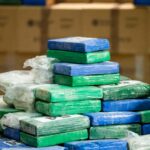There are surprising and potentially carcinogenic chemicals in toilet paper sold in the US, a new study suggests.
Researchers from the University of Florida found evidence of the chemicals in toilet paper sold all over the world and in sewage sludge samples from eight wastewater treatment plants in Florida.
PFAS – or per- and polyfluoroalkyl substances – are synthetic chemicals that last thousands of years and have been linked to testicular and kidney cancers.
Some manufacturers add PFAS when turning wood into pulp, and the chemicals remain in the final paper product.
This is not the first time PFAS have been detected in toilet paper. Last year, scientists found high levels of fluorine in four major brands.
Lead study author Dr Timothy Townsend said: ‘To see this one signature chemical, which we’ve already seen before in the sewage sludge, also turn up in the toilet paper certainly indicated that this is another source that we need to be thinking about when it comes to . . . limiting the amount of PFAS that gets into the environment.’
When toilet paper is flushed, forever chemicals seep into the sewer system.
In addition to certain cancers, PFAS have been linked to myriad other conditions including liver failure, thyroid disease, asthma, and reduced fertility.
PFAS are most commonly found in cosmetics and other personal care products, stain-resistant coatings on carpets and upholstery, pesticides, and firefighting foam.
The Florida research team, led by Dr Townsend, an expert in environmental engineering at the University of Florida, collected toilet paper rolls sold in North, South, and Central America; Africa; and Western Europe and collected sewage sludge samples from U.S. wastewater treatment plants.
Then, they extracted PFAS from the paper and solid sludge in sewage and analyzed them for 34 chemical compounds. The most prevalent among them was a chemical known as disubstituted polyfluoroalkyl phosphates (diPAPs), precursors that can transmute into other, more carcinogenic PFAS.
The researchers said: ‘Our results suggest that toilet paper should be considered as a potentially major source of PFAS entering wastewater treatment systems.’
The researchers then combined their results with data from other studies that measured PFAS levels in sewage and per capita toilet paper use in several countries. They concluded that toilet paper contributed about four percent of diPAPs in the United States and Canada, 35 percent in Sweden and up to 89 percent in France.
The study said: ‘Despite the fact that North Americans use more toilet paper than people living in many other countries, the calculated percentages suggest that most PFAS enter the U.S. wastewater systems from cosmetics, textiles, food packaging or other sources.
‘This study identifies toilet paper as a source of PFAS to wastewater treatment systems, and in some places, it can be a major source.’
Their findings were published Tuesday in the journal Environmental Science & Technology Letters.
The relatively low numbers in the US can be attributed to other sources of PFAS in wastewater, such as cleansers and home cleaning supplies, which also leak directly into wastewater systems.
PFAS are a class of about 12,000 man-made chemicals that have been used in industry and consumer products worldwide since the 1940s, specifically to make products that are resistant to heat, water, and stains.
Surveiling sewage for health threats is nothing new. The Covid pandemic spurred a massive expansion in wastewater monitoring due to its usefulness in flagging emerging variants and case trends.










